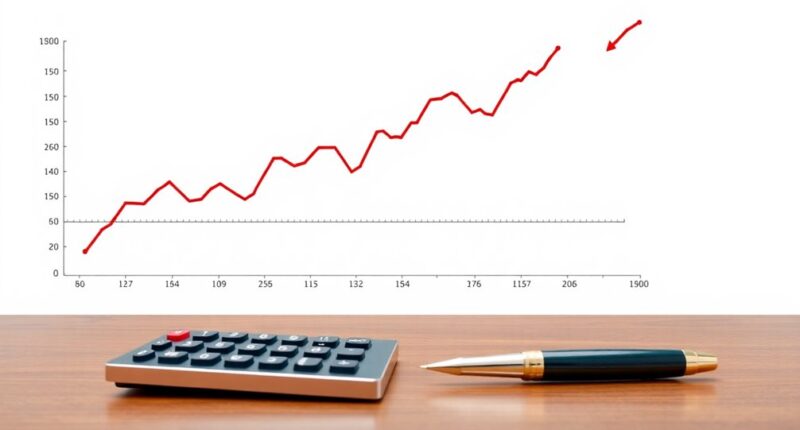The beta coefficient measures how much a stock's price fluctuates compared to the overall market, with the S&P 500 serving as the benchmark at a beta of 1.0. If a stock's beta is greater than 1, it's more volatile and carries higher financial risk. Conversely, a beta less than 1 indicates lower volatility and risk. Understanding beta helps you assess your investment's potential returns and risks, guiding your decisions on portfolio diversification. It's a crucial tool for managing systematic risk effectively. To uncover more insights about its role in investing, keep exploring the various aspects of beta.
Key Takeaways
- Beta Coefficient measures a security's price volatility relative to the overall market, with the S&P 500 as a benchmark set at 1.0.
- A beta greater than 1 indicates higher risk and volatility, while a beta less than 1 suggests lower risk and stability.
- It is crucial for assessing investment risk, estimating expected returns, and informing portfolio diversification strategies.
- Beta is calculated using historical data, but reliance on it can be misleading as past performance may not predict future outcomes.
- In emerging markets, beta coefficients are typically higher, indicating increased volatility and potential for greater returns coupled with higher risks.
Key Financial Risk Indicator

The Beta Coefficient serves as a crucial financial risk indicator, measuring how a security's price fluctuates in relation to the overall market.
By analyzing the beta of a stock, you can gauge its volatility compared to the S&P 500, which has a beta of 1.0. A beta greater than 1 indicates the stock is more volatile and carries higher financial risk, while a beta below 1 shows lower volatility and risk.
This coefficient is calculated using historical data, allowing you to assess the relationship between stock and market returns.
Understanding beta helps you make informed decisions about diversification, aligning your portfolio with your risk tolerance and managing systematic risk effectively.
Understanding Beta's Importance

Understanding how beta impacts your investments can significantly enhance your portfolio management. The beta coefficient measures an investment's volatility compared to the market, helping you assess risk.
A beta greater than 1 indicates higher volatility, potentially leading to higher returns but also increased risk. Conversely, a beta less than 1 suggests lower volatility and risk, aligning better with conservative financial goals.
Investors use beta in the Capital Asset Pricing Model to estimate expected returns based on systematic risk. By grasping beta's importance, you can make informed decisions on portfolio diversification, balancing high-risk investments with safer ones.
This risk assessment not only safeguards your capital but also positions your portfolio to meet your financial objectives effectively.
Beta's Role in Portfolio Management

When managing your portfolio, recognizing beta's role can provide a clearer picture of your investments' risk and potential returns. The beta coefficient helps you assess the systematic risk of individual securities, guiding your asset allocation decisions.
If you prefer growth, high beta stocks can amplify returns during bullish trends. However, low beta stocks offer stability in volatile markets, balancing your portfolio's risk. By calculating your portfolio's weighted average beta, you can align your investments with your risk tolerance and investment goals.
Utilizing the Capital Asset Pricing Model, you can estimate expected returns based on risk profiles. A diversified portfolio that mixes high and low beta stocks can optimize returns while enhancing overall risk management, leading to a more balanced investment strategy.
Pros and Cons Overview

While assessing investment opportunities, weighing the pros and cons of the beta coefficient is crucial. The beta coefficient helps you understand a stock's volatility in relation to the market, which can be beneficial for risk analysis.
High beta stocks might offer higher returns but also come with increased risk, making them attractive for aggressive investors. However, its reliance on historical data can mislead you, as past performance doesn't guarantee future results.
Furthermore, it doesn't account for firm-specific unsystematic risks or external factors like market anomalies. To gain a comprehensive view, combine the beta coefficient with other metrics, such as R-squared values and fundamental analysis, to better understand an investment's risk and potential returns.
Beta vs. Market Volatility

The beta coefficient plays a significant role in evaluating how a stock reacts to market volatility. It measures stock volatility in relation to market fluctuations.
If you're considering a stock with a beta greater than 1, be prepared for larger price movements; these stocks are more volatile than the market. On the other hand, a beta less than 1 indicates a stock that tends to move less dramatically, offering more stability.
Rarely, you might encounter a negative beta, suggesting the stock could rise when the market falls. Understanding these dynamics helps you gauge your risk tolerance and shape your investment strategy, ensuring you choose stocks that align with your financial goals and comfort level.
Market Fluctuation Sensitivity

Understanding a stock's market fluctuation sensitivity is crucial for making informed investment decisions. The beta coefficient quantifies this sensitivity, letting you gauge how a stock reacts to market fluctuations.
A beta value of 1 means the stock moves in sync with the market index, while a value greater than 1 indicates higher volatility and larger price swings. Conversely, a beta of less than 1 suggests greater stability and less sensitivity to market changes.
For example, if a stock has a beta of 1.5, it's expected to rise 1.5% for every 1% increase in the market. Negative beta values imply an inverse relationship, highlighting unique characteristics in the investment landscape, serving as an essential risk measure for your portfolio.
Emerging Market Beta Insights

Investors looking beyond developed markets often find themselves navigating the unique dynamics of emerging markets, where beta coefficients typically reflect higher volatility.
In these regions, the average beta often exceeds 1, indicating more pronounced fluctuations compared to the overall market. This heightened volatility is tied to systematic risk stemming from economic policies, geopolitical events, and currency fluctuations.
Historical analysis reveals that emerging market equities can have betas ranging from 1.2 to 2.0, suggesting they can be 20% to 100% more volatile than developed counterparts.
While such higher beta stocks may offer potential for greater returns, they also come with increased risk exposure. Understanding these dynamics is crucial for crafting a well-informed investment strategy in emerging markets.
Diversify to Mitigate Risk

While navigating the complexities of the stock market, diversifying your investments can be a powerful strategy to mitigate risk. By spreading your capital across various assets, you effectively reduce unsystematic risk associated with individual securities.
Incorporating low beta stocks into your portfolio can further cushion against market volatility, balancing risk and return. A well-constructed diversified portfolio, featuring assets from different sectors, minimizes the impact of poor performance in any single investment.
Research indicates that such a portfolio can cut overall risk by up to 30%. This approach aligns with the Capital Asset Pricing Model (CAPM), emphasizing the importance of both systematic risk, represented by the beta coefficient, and expected returns in effective portfolio construction.
Frequently Asked Questions
What Is the Meaning of Beta Coefficient?
When you hear about beta coefficient, think of it as a measure of how much a security's price moves compared to the overall market.
If it's greater than 1, the security's price is more volatile than the market, while less than 1 means it's less volatile.
A negative beta indicates it moves opposite to market trends.
Essentially, it helps you understand the risk involved when investing in that particular security.
What Does a Beta Coefficient of 1.5 Mean?
A beta coefficient of 1.5 means you're looking at a security that's 50% more volatile than the overall market.
When the market changes by 1%, you can expect this security to swing by 1.5%.
If you're considering this investment, be aware that while it might offer higher returns in a booming market, it could also lead to sharper declines during downturns.
Make sure you weigh your risk tolerance before diving in.
Is a Higher Beta Coefficient Better?
Oh sure, a higher beta coefficient is just what you need for a calm stroll through the investment park!
If you love roller coasters, then go for those high-beta stocks—they can skyrocket or plummet faster than you can blink.
But if you prefer a leisurely walk, low-beta stocks might suit you better.
It all boils down to your risk tolerance; so, choose wisely, or you might end up with a portfolio full of heart palpitations!
What Is β in Correlation?
When you look at correlation, β represents the relationship between variables. If you see a positive β, it means as one variable goes up, the other does too.
A negative β indicates the opposite; when one increases, the other decreases. The size of β tells you how sensitive the dependent variable is to changes in the independent variable.
Understanding this can help you make better predictions and decisions based on your data.
Conclusion
In conclusion, understanding the beta coefficient is essential for navigating investment risks. For example, if you're considering a tech startup with a beta of 1.8, it's likely to be 80% more volatile than the market. This means greater potential gains, but also increased risk. By diversifying your portfolio and keeping an eye on beta, you can make smarter investment choices while managing your exposure to market fluctuations. Don't overlook this vital tool in your financial toolkit!









